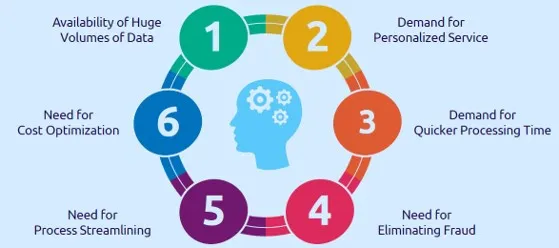Life insurers look to RPA and AI for core processes
Blog: Capgemini CTO Blog
As investment markets across the world remain flat, the life insurance sector bears the brunt of that dormancy. Low investment income and increasing competition have created significant margin pressures on life insurers, which make cost optimization and superior customer experience all the more critical to business.
However, most life insurance value chain processes involve extensive time-consuming and error-prone paperwork. What’s more, operational inefficiency is intensified because policy and customer details are spread out among multiple systems operating in silos.
Within this complex scenario, two technologies may offer life insurers relief: robotic process automation (RPA) and artificial intelligence (AI). As described in the Top-10 Technology Trends in Life Insurance: 2018 report, RPA systems can process structured data, and if the data to be processed is unstructured (such as images and emails), AI systems can help.
Automation can digitalize the processes, thereby reducing processing time and minimizing human errors while integrating different systems for streamlined operations. It can help insurers to not only fix their existing processes but also to leverage new data sources such as social media and connected devices by capturing and processing huge volumes of structured and unstructured data.
In today’s competitive environment, it is becoming important for life insurers to also automate core business processes such as underwriting, policy administration, and servicing, as well as claims processing for better customer service and cost optimization.
RPA and AI can streamline life insurance policy processes and systems
Policy administration and servicing
- RPA and AI can automate document-intensive policy issuance, to significantly reduce turnaround times.
- Policy endorsements can be made more quickly by integrating policy administration systems and automating the process.
- RPA and AI systems can handle renewals and cancellations by automatically sending renewal reminders and capturing feedback during cancellations.
- If customer/policy details change, RPA programs can update required fields within back-end systems.
Underwriting
- Automated systems can underwrite tailor-made policies by doing a personalized risk and need assessment in a quicker point of time.
Claims processing
- Automated claims processing can enable faster claims resolution and settlement, and it can eliminate fraudulent claims more effectively with advanced fraud detection algorithms.
For example, Tokyo-based Fukoku Mutual Life Insurance replaced its manual processes with an AI program that calculates policyholder payouts. The AI system is expected to increase productivity by 30% and deliver a return on its investment in less than two years. The system possesses cognitive technology that enables it to analyze and interpret all types of data including unstructured text, images, and so on.[1]
What is driving automation of life insurance core processes?

Source: Capgemini Financial Services Analysis, 2017
Through automation, most customer transactions can be updated in real-time across databases, with higher speed and accuracy – and at a lower cost. This capability can also help life insurers with regulatory compliance while enabling greater personalization in services and communications.
Automated back-end systems can handle an omnichannel model more efficiently – and from the customer’s vantage point, the experience is seamless. Core systems such as underwriting and claims processing can be scaled up with less additional cost.
The World Insurance Report 2018 (WIR) offers insights, case studies, and advice regarding the critical role RPA and AI will play in helping insurers enhance their digital agility.
Digital agility is poised to become an increasingly important theme in insurance based on customers’ evolving preferences together with rising margin pressures. In fact, more than 80% of WIR 2018 survey respondents said customer demand was a top driver for digital agility, while 45% cited shrinking margin pressures.
Increasingly, life insurers are beginning to understand the benefits of RPA and AI. In fact, more than 45% of life insurers say they are actively deploying RPA systems, and another 35% say they are in the pilot phase, according to the WIR 2018 – making RPA the most-sought automation tool for insurers.
More than 55% of life insurers said their firms were piloting or deploying AI solutions, with P&C insurers being only slightly more active than life insurers and health insurers when it came to leveraging AI.
Also, across sectors, more than 25% of insurers said they are leveraging RPA and AI to design smart core processes that can manage real-time, personalized transactions throughout the value chain.
WIR 2018 survey responses are an indication of changing times. Today, life insurers are actively exploring new technologies with the realization that to remain competitive, previously good-to-have tools have become must-have applications. To learn more about the Top-10 Technology Trends in Life Insurance: 2018, click here.
# # #
[1] The Guardian, “Japanese company replaces office workers with artificial intelligence,” Justin McCurry, January 5, 2017, https://www.theguardian.com/technology/2017/jan/05/japanese-company-replaces-office-workers-artificial-intelligence-ai-fukoku-mutual-life-insurance